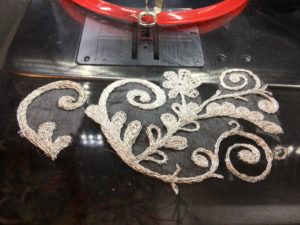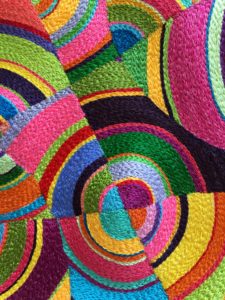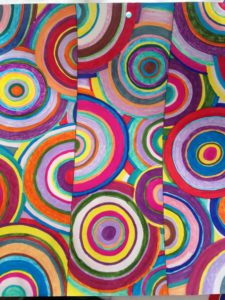I always want to be curious!
In this series, I’m re-acquainting myself with the curiosity these artists evoked in me. Somehow, someway, they have all inspired me to research, learn and push myself, and that’s a good thing!
Research, learn and stretch myself…..

Sampling promotes curiosity and curiosity promotes sampling!
Alice Kettle, English Embroiderer/Artist
Of her work, Alice Kettle once said, ‘If my work became totally abstract, I believe it would fragment. The figure is the absolute essence of my work, the human content, the emotional link for me as an artist’. Audrey Walker MBE, then Head of Embroidery and Textiles, Goldsmiths’ College (retired), wrote ‘I anticipated small-scale, hand embroidered work from Alice – how wrong I was! This gentle person had an inner core of toughness, physical stamina and huge ambition for her work. The industrial sewing machine became her natural tool, and fabrics were pounded into submission as her imagination soared. She explored the world of historical embroidery and released herself from the constrictions of the rectilinear format. Embroideries began to flow across the wall and onto the floor. The discharge of energy has continued and she has never stopped working’.
I try to make use of every opportunity to work and surround myself with people who inspire me.

I really had to think about how to stitch this shirt. Problem solving is integral to my process. Original work using circles inspired by Sonia Delaunay. (Repurposed shirt).
I was privileged to attend a Masterclass with Alice a number of years ago. Five days of inspiration, dedication and discovery. It was an amazing experience. Audrey Walker’s words, above, rang true indeed. I first came across Alice’s work through a book entitled ‘Eye of the Needle, The Textile Art of Alice Kettle, Published by Telos Art Publishing, Winchester, UK, 1995. I was attracted by the scale and freedom of stitch. Her work from this time rippled with dimension, colour and free flowing, abstracted figures. Whether her work hangs as part of a contemporary exhibition in a commercial gallery or as an altar frontal in Winchester Cathedral, it glows with her personality and expressiveness through stitch. Listen to Alice speak about her work here. This amazing artist is well worth further research.

Josef Albers, German-American Artist, Poet, Sculptor, Teacher and Theoritician.
Throughout my study of colour, Josef Albers became the one voice I truly understood. I think that’s the difference with Albers. His method of teaching was to learn to see and feel colour and to use that to cultivate your imagination. He once said, ‘art means you have to believe, to have faith, that is, to cultivate vision’. He placed practice before theory and that resonated with me. By all accounts, Albers had a sense of wonder he was able to share with his students. That’s rare. Click here for a video of Nicholas Fox Weber, of the Josef and Anni Albers Foundation, giving a presentation on ‘Josef Albers Minimal Means, Maximum Effect’.
‘Open the eyes’ Josef Albers.

Digging deeper to see new possibilities in my work with circles. ‘Shattered’ 2018.
A student of Johannes Itten, Albers progressed to teach alongside Paul Klee and Wassily Kandinsky on the faculty at the Bauhaus in Germany. Moving to America with his wife, Anni Albers, he went on to teach notable artists Cy Twonbly and Robert Rauschenberg. His book ‘Interaction of Colour’, published in 1963, is a steadfast favourite of mine. If you haven’t read it yet, give it a go and see what you think. Click here to visit my Pinterest board featuring Josef Albers.
Understanding the properties of colour allows me the freedom to challenge and explore.

Studying Josef Albers consolidated my ideas about how to work with and use colour.

Freedom to explore is what I need to keep moving forward. Understanding the myriad properties of colour is part of that.
My mantra is to ‘work more, do more’. For me it’s the only way to keep creating, and that’s my passion!
I’m always curious.
![]()

